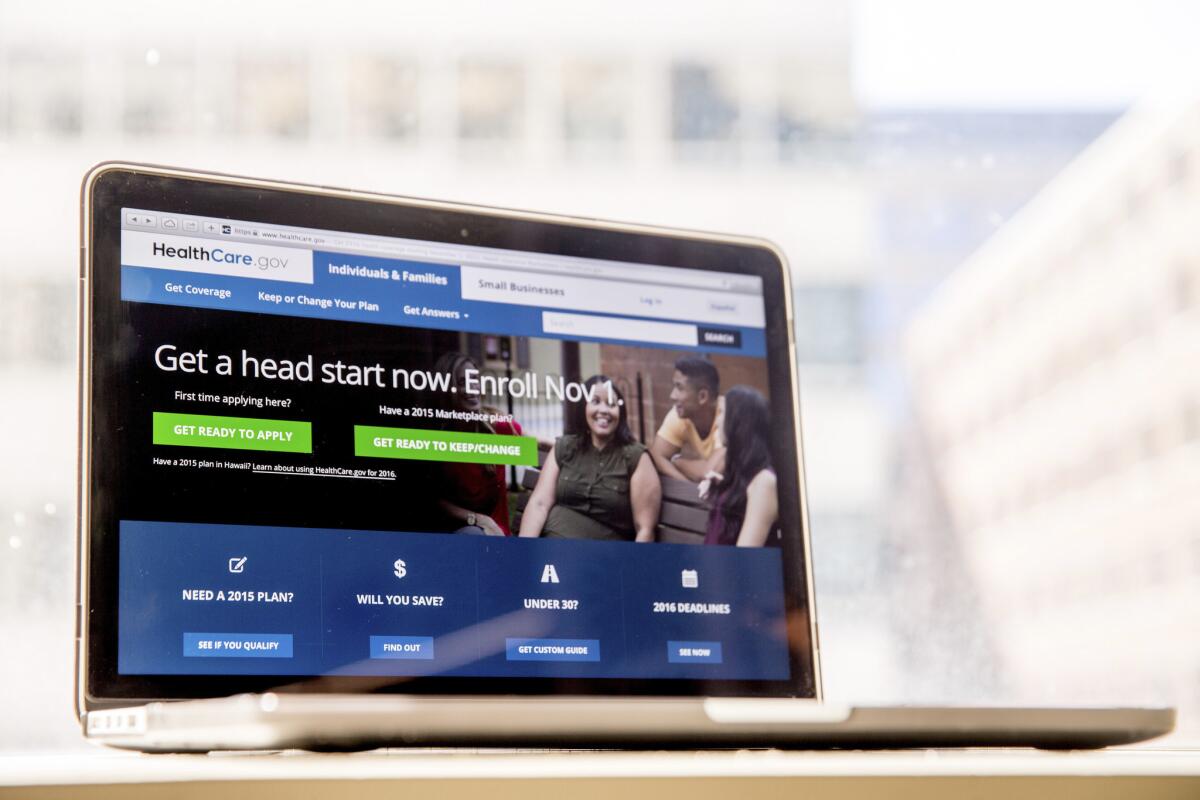Column: Obamacare ‘gaming’ update: Feds, California tighten up on documentation for special enrollments

Did you miss open enrollment for Obamacare? If you’re cliaming a life-event change to join up now, be prepared to submit documentation.
The notion that mobs of Americans are actively plotting to cheat the Affordable Care Act by waiting until they get sick and then finding an excuse to sign up for health insurance is cherished by two groups: anti-Obamacare conservatives and insurance companies.
As we’ve pointed out in the past, neither group has actually come up with data to substantiate their claim that this produces huge losses in the individual exchange market.
But there plainly are good reasons to close any loopholes.
We want to maximize enrollment of people who are eligible, but also as a matter of program integrity make sure that people who aren’t eligible don’t get in.
— Peter V. Lee, exeucitve director of Covered California
The Department of Health and Human Services on Wednesday announced that it would be tightening the verification rules for customers signing up for insurance during special enrollment periods. This is the time frame outside the annual three-month open enrollment period, when anyone can enroll in an individual health plan.
Special enrollment is reserved mostly for those with a major life change warranting a change in insurance or new enrollment. Under the new federal rules, anyone claiming eligibility under four major special categories will have to submit documentation. These categories are the loss of coverage, typically through a job loss; a permanent move, usually to a new state; birth, adoption or financial responsibility for a child; and marriage. The government says these accounted for three-fourths of all special enrollments on the federal exchange website in the last half of 2015.
Covered California, the state’s ACA exchange, is also taking steps. Following a presentation on the potential cost of ineligible enrollees taking advantage of special enrollment periods, the exchange is moving toward requiring verification of eligibility for some categories starting in June. Covered California’s board will vote on the matter in April, but they’ll be responding to a report by their actuary that some health plans in the state are so concerned about the higher costs of covering special period enrollees that they might seek additional premium increases of 2% to 5% for next year “if we do nothing,” says the exchange’s executive director, Peter V. Lee.
“We’re very mindful of the impact of a premium increase of 2% to 5%,” Lee says. That wouldn’t be enough to provoke the dreaded insurance “death spiral” in which higher premiums drive off healthier customers, leaving progressively sicker populations to dominate the risk pool and sending premiums even higher, but it would certainly burden enrollees who don’t receive premium subsidies and thus might be inclined to drop their coverage.
It’s unlikely that ineligible enrollees alone are the cause of reported losses by ACA insurers. UnitedHealth Group, which has emerged as the emblematic big insurer unhappy with the ACA market, has said that it lost $475 million in that market last year and has already reserved $245 million against losses this year.
Losses on that scale would require massive gaming by thousands of customers; the root cause of the problems seen by United may be that, inexperienced in the individual market, the firm underpriced its health plans to attract customers and suffered buyer’s remorse when the customers turned out to be sicker than it expected.
The question isn’t whether there’s any gaming going on; in any market as large as the ACA’s, with as many facets, there are surely some people who face the desperation of big medical bills, have figured out how to take advantage and found the opportunity to do so.
Whether there are so many “gamers” that Obamacare itself is threatened, or so many loopholes that it makes no sense for a rational person to sign up for insurance during annual open enrollment periods, as Aetna asserted in a recent government filing, is doubtful. Among other factors, most people would prefer to have insurance than go without -- that’s why there was public pressure on Congress and the White House to reform the health insurance market in the first place.
Some complaints from insurers are consistent with the expected profile of special enrollees. For several reasons, they tend to be sicker or have higher health needs than the general public. An uninsured individual who falls ill is more likely to be on the lookout for the opportunity to enroll, but that’s not the same as deliberately waiting.
Also, newborn babies, who probably account for a sizable plurality of special enrollment cases, are “much more expensive than other children” and remain so for their first year.
But how much more expensive should the special enrollment pool be, compared to the overall exchange population? Among California’s four largest exchange insurers, one found no difference in the cost of the two pools. The other three, however, cited differentials ranging from 15% to 50%, all of which seemed higher than expected.
Another point of concern was that insurers told the Covered California staff that demanding proof of special enrollment eligibility from applicants in the off-exchange market -- these are higher-income customers ineligible for premium subsidies -- made 15% to 35% of them “disappear,” a possible indication that at least some weren’t really eligible. (Asking people to jump through hoops typically drives even some eligible applicants away, especially those who may be healthy and not desperate for coverage.) Off-exchange members account for about a third of the more than 1.8 million enrollees in the California individual market.
Some health plans documented “hundreds of cases” in which off-exchange applicants denied coverage because they couldn’t produce proof simply reapplied via California and signed up without documentation, Covered California says.
Even in the face of these vague indications of gaming, Covered California actually is stepping up its outreach to potential special enrollees, rolling out radio and digital ad campaigns to make sure that those who are eligible know it.
It probably makes sense for the federal and state exchanges to require documentation of the most common life events, where the verifications are easiest to provide. “We want to maximize enrollment of people who are eligible,” Lee says, “but also as a matter of program integrity make sure that people who aren’t eligible don’t get in.”
Tightening the special enrollment rules also could be effective at encouraging people to comply with the individual mandate during open enrollment. Under Obamacare, people who lack coverage are subject to a monthly tax penalty. For the current year, the penalty is 2.5% of income, or $695 per adult and $347.50 per child, to a maximum of $2,085.
That’s a pittance compared to the cost of obtaining treatment without insurance for a serious disease. Knowing that the loopholes for special enrollment have been sewn shut could make people think more seriously about the cost of bad health.
“The penalty pales in significance,” Lee says, “compared to getting a diagnosis of uterine cancer in June and getting stuck with a $100,000 bill.”
Keep up to date with Michael Hiltzik. Follow @hiltzikm on Twitter, see our Facebook page, or email michael.hiltzik@latimes.com.







